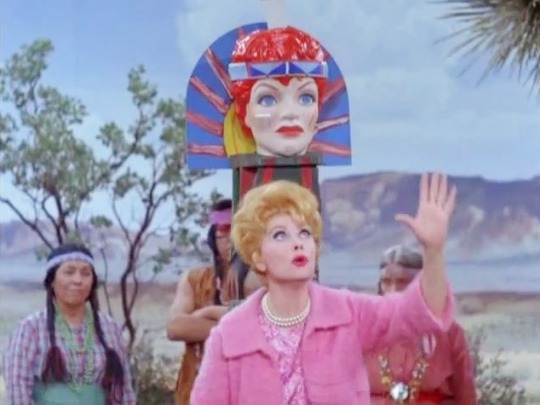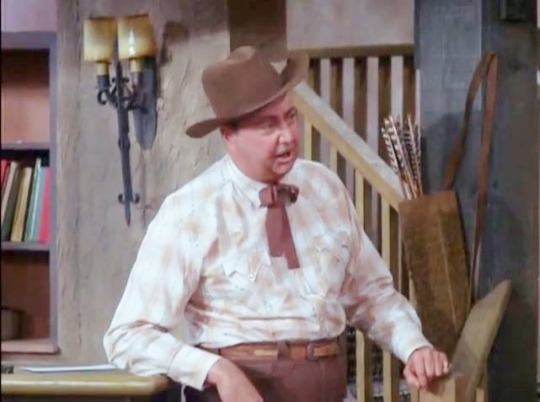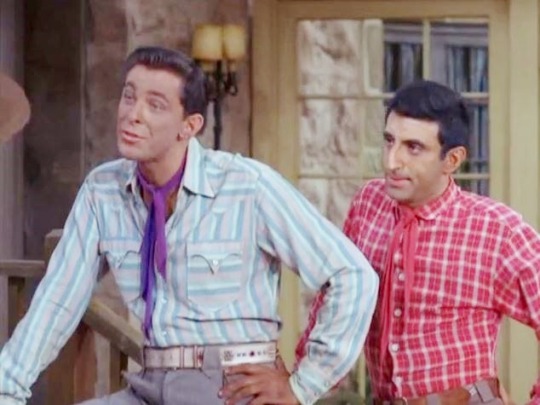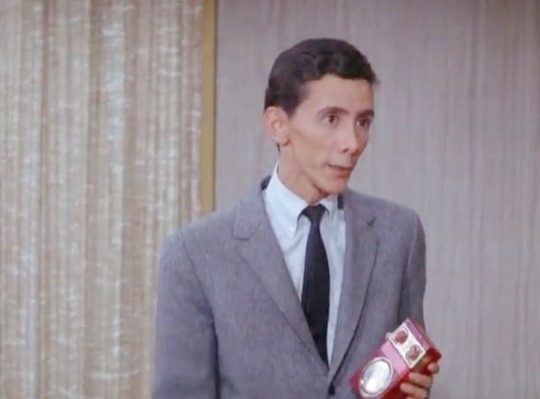S4;E15~
January 3, 1966


Synopsis
When
Mr. Mooney escapes to a dude ranch without signing some important bank papers, Lucy follows him and is mistaken for a rain goddess by a
nearby Native American tribe.
Regular
Cast
Lucille
Ball (Lucy Carmichael), Gale Gordon (Theodore J. Mooney)
Mary
Jane Croft (Mary Jane Lewis) does not appear in this episode,
although Lucy does have a phone conversation with her.
Guest
Cast

Willard
Waterman
(Tex Critter) was
a versatile voice actor who appeared on hundreds of radio shows in
the 1930s and 40s. He is probably best remembered for playing ‘The
Great Gildersleeve’ on both radio and TV. He previously played TV
host Greg Gregory in “Lucy and the Plumber” (S3;E2).
Tex
Critter is the Tumbleweed Inn’s social director. The character’s
name is a pun on Tex Ritter, a
country music singer and movie actor popular from the mid-1930s into
the 1960s.
Ritter is mentioned in “Lucy Goes to the Rodeo” (ILL S5;E8). He is the father of sitcom star John Ritter, one of Lucille Ball’s favorites.

Douglas
Fowley (Chief, above left) was first seen with Lucille Ball in
the 1935 film musical Old Man Rhythm. In 1952 he played movie
director Roscoe Dexter in the film Singin’ in the Rain.
The
Chief is Dick’s father.
Larry Blake (Medicine Man,
above right) was a former vaudevillian who began doing movies in
1937. He will do eight episodes of “Here’s Lucy.”
The
Medicine Man is Vince’s father.

Jamie Farr (Vince,
above right) is probably best known as the cross-dressing Klinger on
TV’s “M*A*S*H” (1972-1983). This is his only appearance opposite
Lucille Ball.
Vince’s
Indian name is ‘Wolf With Nose Like Anteater’.
Alan
Reed Jr.
(Dick, above left) is the son of Alan Reed, who voiced Fred
Flintstone. Although this is his only appearance on “The Lucy
Show,” his father appeared in “Lucy Visits the White House”
(S1;E25).
Dick’s
Indian name is ‘Running Bear Who Smell Like Skunk’.

Marc
Cavell
(Herbie, Bank Office Boy) made his screen debut in 1949. This is his
only appearance with Lucille Ball.

Bennett
Green
(Ranch Guest, above right) was
Desi Arnaz’s camera and lighting stand-in during “I Love Lucy.” He does occasional
background work on “The Lucy Show.”
Hazel
Pierce
(Ranch Guest, above left) was
Lucille Ball’s camera and lighting stand-in throughout “I Love
Lucy.” She also made frequent appearances on the show. Of her many
on-camera appearances on “The Lucy Show” only once was she given
a character name and credited, in “Lucy
Plays Cleopatra” (S1;E1).
She was also an uncredited extra in the film Forever
Darling (1956).

Renita Reachi (Ranch Guest, behind Lucy) was a costumer for “The Lucy Show” from 1966 to 1968. She was also Vivian Vance’s camera and lighting stand-in for “I Love Lucy” and “The Lucy Show.” She was a costumer and/or made crowd appearances on “Here’s Lucy” and the Lucille Ball films Yours, Mine and Ours (1968) and Mame (1974).

Bobby
Gilbert
(Ranch Guest) was
born Robert Wolf in 1898. A vaudevillian, he was one of the first
performers to play the South Pacific on USO tours during WWII. He was
an extra in such hit musical films as Some
Like It Hot
(1959), How
To Succeed in Business
(1967), Thoroughly
Modern Millie (1967)
and Bednobs
and Broomsticks (1971).
This is the second of his two appearances on “The Lucy Show.”
Roy Rowan is the voice of the radio announcer. He generally voices any TV or radio broadcasts that are part of the plots of “The Lucy Show,” but has also appeared on camera.
Other
Ranch Guests and Native Americans are played by uncredited
performers.


This
is the first new episode of 1966. The script was finalized on
November 3, 1965. This is the first and only episode written by Brad
Radnitz and Bruce Howard. This was Radnitz’s first script for TV.
It
sounds as if Gale Gordon is having vocal problems during the episode.

Lucy
jokingly calls Mr. Mooney Captain Bligh. William Bligh
(1754-1817) was a British navy captain of the HMS Bounty whose crew
staged a mutiny in rebellion of his tyranny. The story is the basis
four five films and a stage musical. Lucy is probably thinking of
the 1962 film Mutiny on the Bounty starring Trevor Howard as
Bligh and Marlon Brando as Mr. Christian.
The
office boy’s transistor radio is blaring “Do the Watusi.” The
music, without lyrics, was also heard in “Chris’s New Year’s Eve
Party” (S1;E14).

Trying
to figure out where Mr. Mooney might have gone for his secret
get-away, she reads newspaper ads for the Tyrol Room, the Round-Up,
Spanish Hacienda, Lazy Days, and Shady Nook Nudist Colony. Lucy
rejects the idea of the nudist colony because she says Mr. Mooney
used to blush when he watched “Naked City.” “Naked
City” (1958-63)
was a TV series about the cases of New York’s 65 precinct. The metaphorical title comes from the final lines of the
show: “There
are eight million stories in the naked city. This has been one of
them.” Lazy
Days was also the name of
the health farm in “Lucy and the Countess Lose Weight” (S3;E21).

Mr.
Mooney’s secret getaway is the Tumbleweed Inn in Indian Rock (not to
be confused with the Indianweed Inn in Tumblerock), two hours outside
of Los Angeles, where he is known as ‘Hopalong’ and dresses in black
cowboy duds.

To
convince the Chief and the Medicine Man she is friendly, Lucy says:
“Me hate John Wayne.” John Wayne
played a cowboy in most of his films. He played himself on “I Love
Lucy” in 1955 and will do so again on a season 5 episode of “The
Lucy Show.”

When
asked to do a rain dance, Lucy asks the Native American drummer: “Do
you know ‘Stormy Weather’? How about ‘April Showers’? ‘Singin’ in
the Rain’?” “Stormy
Weather”
is a 1933 song written by Harold
Arlen
and
Ted
Koehler.
Ethel
Waters
first
sang it at The
Cotton Club in Harlem.
In 1965 it was covered by Bing Crosby. “April
Showers”
was written by Louis
Silvers and
B.G. De Sylva and introduced
by Al Jolson in the 1921 Broadway
musical Bombo.
“Singin’
In the Rain”
is by Arthur
Freed and
Nacio Herb Brown published
in 1929. It became the centerpiece of the 1952 musical
film of
the same name. Coincidentally, Douglas Fowley (the Chief) played a
supporting role in the film.

For
her improvised rain dance, Lucy does pantomime and a few steps of the
Charleston. She earns a round of applause from the studio audience.
To the rhythmic beat of the drum, she then launches into bumps and
grinds like a stripper, even miming removing gloves and tossing them
away. Instead of a cloud burst, they are showered with oil when
Vince and Dick strike a nearby gusher.
As
was usual with films and TV shows of the time, the Native American
characters were played by white and mixed race actors of dark
complexion. The script also indulges in humor derived from
stereotypical speech patterns of Native Americans, although the
presence of two tribe sons (Dick and Vince) who speak and act like
most modern teens, helps keep the comedy in perspective.
Callbacks!

This is not the first time Lucy was atop a totem pole. The April 17, 1953 edition of TV Guide (the third national edition ever) had Lucy and Little Ricky atop a TV totem pole featuring Cid Caesar, Imogene Coca, Milton Berle, and Arthur Godfrey, all TV icons of the early 1950s.

Lucy
dressed like a Native American squaw in both “Lucy and the Scout
Trip” (S2;E26) and “The
Indian Show” (ILL S2;E24) wearing the same exact outfit. This
costume is different – it is powder blue, a color that favored
Lucille Ball.
Blooper
Alerts!

In
the prop newspaper, an ad for the Palace Theatre uses the same
font seen in a newspaper in “Ricky’s Old Girlfriend” (ILL S3;E12)
in 1953!

“Lucy, the Rain Goddess” rates 3 Paper Hearts out of 5

Leave a comment